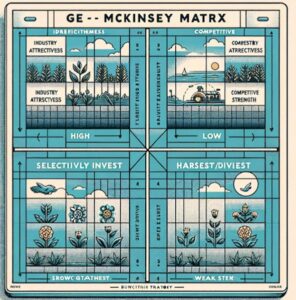Value Net Model (Brandenburger and Nalebuff)

The Value Net Model, conceptualized by Adam Brandenburger and Barry Nalebuff, is a strategic analysis tool used in the field of management consulting to understand a company’s competitive environment. This model extends beyond the traditional analysis of competitors to include four key types of business relationships: customers, suppliers, competitors, and complementors. These elements are arranged in a cross-shaped diagram representing the company’s value net, a framework that helps identify and analyze the interconnections and dynamics among these groups. The model encourages organizations to view their competitors not just as rivals but also as potential partners that can add value to their business.
Key Components of the Value Net Model
- Customers: Individuals or organizations that buy or use the company’s products or services.
- Suppliers: Entities that provide the company with the inputs (goods, services, information) it needs to produce its products or services.
- Competitors: Companies that offer similar products or services to the same customer base.
- Complementors: Entities that provide complementary products or services, which, when used together with the company’s offerings, enhance the value of both.
Application in Strategic Planning
The Value Net Model is instrumental in strategic planning as it provides a comprehensive view of the competitive landscape. It helps companies identify opportunities for collaboration, co-opetition (cooperative competition), and strategic alliances. By understanding the roles of complementors and competitors, companies can explore innovative ways to create value for customers, differentiate their offerings, and achieve a competitive advantage.
Similar Tools and Methodologies
- SWOT Analysis: A tool that helps organizations identify their Strengths, Weaknesses, Opportunities, and Threats. While the SWOT Analysis offers a broad overview of internal and external factors, the Value Net Model specifically focuses on the competitive environment.
- Porter’s Five Forces: A framework for analyzing the level of competition within an industry and business strategy development. It focuses on five forces that shape every industry and market. Unlike the Value Net Model, it does not explicitly consider complementors.
- Blue Ocean Strategy: A strategy that encourages companies to create new demand in an uncontested market space, or a “Blue Ocean,” rather than competing head-to-head with other companies in an existing industry. This approach complements the Value Net Model by emphasizing innovation and value creation.
In conclusion, the Value Net Model by Brandenburger and Nalebuff offers a unique perspective on strategic analysis, encouraging companies to look beyond traditional competitors and consider a wider array of relationships in their competitive strategy. This model is particularly useful for organizations looking to explore innovative strategic alliances and partnerships to enhance their competitive positioning.



